LARGE FORMAT LOOK TEST: ALEXA 65 vs. ALEXA MINI
With the rising trend of large format digital cinema cameras (e.g. Alexa Mini LF / RED Monstro / Sony Venice / etc.) more and more people start discussing the Large Format Look. Because there are many misleading formulations and expectations on the Large Format Look, I want to take a closer look at how the sensor size influences the final image. To make the differences as significant as possible I compare the super 35mm Alexa Mini with the 65mm Alexa 65, which is the largest sensor digital cinema camera on the market right now.
Both cameras are mounted into a stereoscopic rig, so the cameras are recording the same scene and action with the same perspective center simultaneously. The cameras are recalibrated after every lens change so the nodal points of both systems match perfectly.
The fact that the Alexa 65 uses 3x the ALEV-III Sensor of the Alexa Mini (and stitched together to one big sensor) makes these two cameras a perfect combination to compare just the different sensor sizes. Since they are actually based on the same sensor, the color science, dynamic range, and other factors stay consistent and won’t distract from the main test aspects.
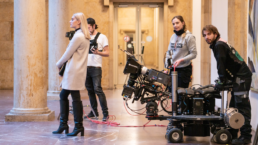
The basic approach of this test is to keep the same angle of view and the same camera position on both cameras. On a real-world set, space is limited most of the time and the physical distance of the camera to the subject is mostly based on the storytelling approach of the cinematographer, no matter what format he shoots on. To get the same angle of view on both cameras, I adjusted the focal length by the value of the crop factor.
Recording Format:
Alexa 65: 6.5K Open Gate ArriRaw, 25p
Alexa Mini: 3.4K Open Gate ArriRaw, 25p
As described in the section “Crop Factor” the actual used sensor area differs from the original recording mode.
Lenses:
Arri Rental DNA Prime 45mm T2.3
Arri Rental DNA Prime 35mm T2.3
Arri Rental DNA Prime 70mm T2.8
Arri Signature Prime 18mm T1.8
SUMMARY AND EXPLANATION OF THE TEST RESULTS
1.) Crop Factor
Different sized sensors come with different crop factors which leads to a different angle of view when using the same focal length on both formats. The Alexa Mini has a crop factor of 1.27 compared to LF/ Full Frame, whereas the Alexa 65 has a crop factor of 0.70. In the following you can see the resulting images of a 45mm lens on both cameras put together into one frame:
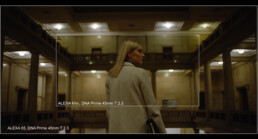
With Arri’s frame line and lens illumination tool, you can find out the actual used sensor area in different recording modes. The whole test was shot in a 2:1 aspect ratio which has to be considered in order to calculate the used sensor area. The Alexa Mini uses in ArriRaw 3.4K Open Gate mode (at 2:1 aspect ratio) a sensor area of 28.25 x 18.17 mm. The Alexa 65 uses in ArriRaw 6.5K Open Gate mode (at 2:1 aspect ratio) a sensor area of 51.15 x 25.58 mm. Knowing these values, the crop factor can be calculated by dividing the sensors diagonals by each other:
Relative crop factor of the Alexa 65 to the Alexa Mini:
57.19mm / 31.58mm = 1.81
In order to match the angle of view by focal length compensation, the focal length needs to be multiplied by the crop factor.
Example: 18mm Lens on the Alexa Mini:
18mm x 1.81 = 32.58mm
To get the same angle of view you would need to use an 18mm lens on the Alexa Mini and a 32 mm lens on the Alexa 65. Since most focal lengths on prime lenses only come in hard steps of (18, 25, 35, 50, etc.) I had to go with a 35mm DNA Prime instead of a 32mm on the Alexa 65. To match the resulting deviation of the angle of view I needed to crop the sensor of the Alexa Mini slightly. The same correction was necessary for the 35mm and 70mm focal lengths.
After the crop, the used sensor area of the Alexa Mini still counts at least 2740×1370 photosites which is approximately the same as in the regular 2K ProRes 4444 mode. Anyway, it is important to keep in mind that the Alexa Mini doesn’t use its maximum potential in this test since its full sensor is actually bigger and has a higher resolution of 3424×2202 photosites. Also, the mirror of the 3D rig affects both cameras‘ image quality (-1 stop of light, color tints, loss of contrast) so both cameras would perform slightly better under real shooting conditions.
2.) Depth of Field
Because of the use of a 1.8x longer focal length to get the same angle of view on both formats, you get a shallower depth of field on the Alexa 65. The blur circle diameter of an out of focus object is 1.8x larger on the Alexa 65 so the background appears more out of focus. It’s important to keep in mind that the blur circles are getting bigger with the factor of magnification, which is proportional to the focal length and is not influenced by the size of the image plane.
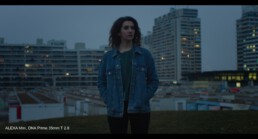
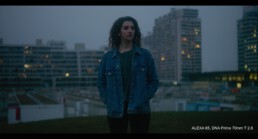
To match the amount of background blur on both formats you need to close down the aperture by the value of the crop factor of 1.81 stops. Putting it the other way around, you get a shallower depth of field appropriate to 1.81 stops on the Alexa 65 compared to the Alexa Mini when shooting at the same F-Stop.
Example: Calculating the F-Stop for the Alexa 65 that matches the amount of background blur of an F2.8 on the Alexa Mini:
2.8 x 1.81 = 5.1
In the portrait test I closed down the aperture to nearly T5.6. On the second image we can see that the background blur now matches on both cameras.
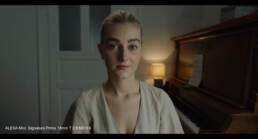


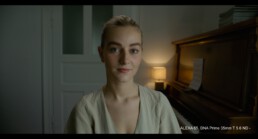
In the case of a Full Frame/ Large Format camera like the Alexa Mini LF, the relative crop factor compared to the s35mm Alexa Mini is 1.3. That means that you get a shallower depth of field appropriate to 1.3 stops on the Alexa Mini LF when shooting at the same F-Stop.
A closer look at the theoretical background of blur circles can be found in this article by cinematographer Steve Yedlin or in my full thesis (German language only).
2.) Perspective and Distortion
A common expectation on Large Format Cinematography is the change in perspective, distortion, and rendering of space. This is probably because of the different use of focal lengths to achieve the same angle of view on both formats. It’s often said that long focal lengths are compressing the space whereas short focal lengths are stretching it. Based on these misconceptions one could expect that an image shot on an 18mm lens on an Alexa Mini would lead to a different rendering of space than the same frame shot on a 35mm lens on the Alexa 65.
If we take a look at the actual test results we see that they produce exactly the same image. Especially when taking a closer look at the overlaps of the actress with the background it’s obvious that there is no difference in perspective or foreground to background relation.
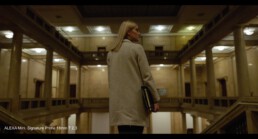

This is because perspective doesn’t depend on focal length or format size. According to its definition perspective describes the spatial relation of objects in space in relation to the position of the viewer. That means that only a different camera position or a change in the subject’s position can lead to a change in perspective.
The same rule applies when shooting a portrait on an 18mm lens on the Alexa Mini and a 35mm lens on the Alexa 65:


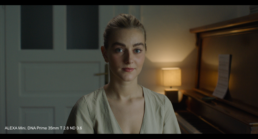
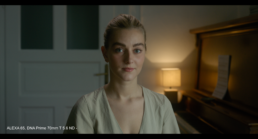
The reason why we often hear that longer focal lengths are compressing the image is that longer focal lengths reduce the angle of view and you have to move the camera further away from the subject in order to get the same framing. This change in camera to subject distance leads to a different perspective and space looks more compressed.
Although shorter lenses tend to have more distortion than longer lenses, its influence on the image when comparing two sensor sizes is very little in most cases. Modern cinema lenses (e.g. Zeiss Master Primes) are very well corrected so that even wide focal lengths like 12mm or 14mm barely have a visible amount of distortion. The amount of distortion is mostly based on the quality of the lens series and not necessarily on the individual focal length. Because of that, even a 35mm lens can have more distortion than an 18mm lens which in fact can be seen in skyscraper shot (04:28) in the test.
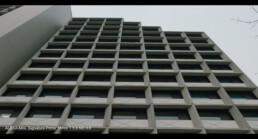
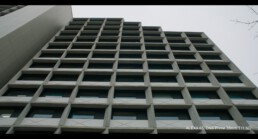
3.) Noise Performance
Larger format sensors have the ability to produce less noise. This is because they can have both a bigger and a higher count of photosites on their surface. Generally, there are many different kinds of image noise and they can have very different causes. Image noise can be described by the so-called Signal to Noise Ratio (SNR) which gives information about the relation between the whole signal and the amount of noise it contains. Arri is known for its especially large pixels that are very sensitive to light. The larger a photosite is the more photons it can catch in a given amount of time which leads to a stronger signal. The stronger the resulting signal, the smaller the amount of shot noise compared to the entire signal. In this case the SNR is higher and the image contains less noise.
The perceived intensity of image noise depends not only on its standard deviation but also on its spatial frequency. The spatial frequency of the noise changes with the resolution of the sensor. The higher the resolution the higher is the spatial frequency which makes the noise appear more subtle.

Source: Cambridge In Colour (https://www.cambridgeincolour.com/tutorials/image-noise-2.htm)
In order to achieve a higher sensor resolution, the sensor needs to be larger or the photosites need to be smaller. As already mentioned larger photosites generally offer a better noise performance. To get a higher image resolution, without compromising the pixel size, one option is to increase the size of the sensor.
The special thing about the Alexa Mini and Alexa 65 is, that they are based on the same sensor and work with exactly the same photosites. The only difference is the sensor size and the number of photosites, which counts 3424 px horizontally in case of the ALEXA Mini and 6200px in case of the ALEXA 65.
To see the differences in noise performance, I compared both cameras in a low light interior scene. The scene is generally underexposed and lit in the following intensities:

I shot the test at different exposure indices at 800, 1600, and 3200 ISO. At the same time I lowered the exposure of the sensor step by step while putting in ND filters of ND 0.3 /0.6.
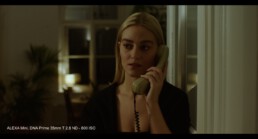
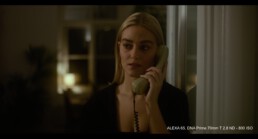
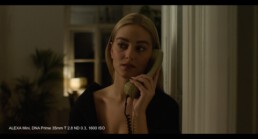
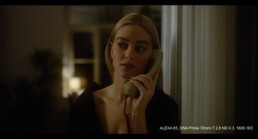
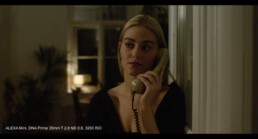
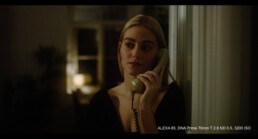
4.) Resolution
One of the most obvious technical differences between the Alexa Mini and the Alexa 65 is their native sensor resolution. The Alexa Mini has a maximum resolution of 3424px (3.4K) horizontally whereas the Alexa 65 uses 6560px (6.5K) in Open Gate Mode. Especially when cropping into the image, you can see the remaining amount of resolution and detail of the Alexa 65s image compared to the Alexa Mini.
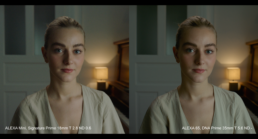
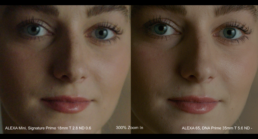
As already mentioned both sensors are based on the same large pixels that Arri is known for and the only difference is the overall amount of pixels. Larger pixels are able to catch more light and most of the time do offer a better low light performance. The large sensor of the Alexa 65 offers the possibility to higher the resolution without compromising the pixel size. This leads to a general increase in image detail while remaining a great low light performance, which is also a benefit the Alexa LF / Mini LF is known for.
5.) Conclusion
The („large format“) look that we see in this test is created not only by the format size but it’s a result of the combination of the sensor size the lens choice.
Regarding the format size, its main influence on the image is a shallower depth of field when having the same angle of view at the same relative aperture (F-Stop).
Also, a larger sensor has the advantage of providing a higher native resolution while still being able to remain a comparatively large pixel size. This may lead to a better low light performance with a higher spatial frequency noise that looks finer grained and more subtle.
In terms of perspective, the image isn’t influenced by either the format size or focal length like it’s often assumed. A change in perspective or different compression of the space can only be achieved by changing the distance of the camera to the subject.
When it comes to the lens, we can see that the DNAs produce a strong vignette as well as add a slight diffusion to the entire image. They have a clearly visible amount of distortion and the shape of the blur circles on the image plane changes to the edge of the lens. The Alexa Mini with its smaller sensor doesn’t use the edge areas lens, where the vignetting and distortion have their strongest impact, which leads to an overall „cleaner“ or „flatter“ image.
I think it can be defined as a part of the large format look, that especially sensors larger than s35mm allow you to use these outer areas of lenses where all the imperfections (vignetting, blur, distorted bokeh, etc.) happen.
Since there are many misconceptions about the large format look, especially on the relation between focal length, angle of view, and perspective, I hope this test could solve some of the mysteries about the „large format look“.
If you have any questions feel free to contact me at kontakt@manuel-luebbers.de or Instagram.
For an accurate evaluation of the test results, the test should be watched on a cinema screen without the compromises of Youtube/ Vimeo’s compression algorithms.
With the kind support of:
References:
Yedlin, Steven: On Common Misconceptions About Large Format Optics, 2019, https://www.yedlin.net/NerdyFilmTechStuff/LargeFormatMisconceptions.html [14.05.2020]
Arri: ALEV Sensors, https://www.arri.com/en/learn-help/technology/alev-sensors [14.05.2020]
Wikipedia, Formatfaktor, https://de.wikipedia.org/wiki/Formatfaktor [01.05.2020]
Arri: Frame Line & Lens Illumination Tool, https://www.arri.com/en/learn-help/learn-help-camera-system/tools/frame-line-lens-illumination-tool [01.05.2020]
Arri: Formats and Data Rate Calculator, https://www.arri.com/en/learn-help/learn-help-camera-system/tools/formats-and-data-rate-calculator [01.05.2020]
Wikipedia: Circle of Confusion, https://en.wikipedia.org/wiki/Circle_of_confusion [01.05.2020]
Yedlin, Steven: Matching Lens Blur on Different Format Sizes, 2017, https://www.yedlin.net/NerdyFilmTechStuff/MatchLensBlur.html [06.05.2020]
Wikipedia: Perspektive, https://de.wikipedia.org/wiki/Perspektive [06.05.2020]
Vision Doctor: Verzeichnung von Objektiven, https://www.vision-doctor.com/optische-fehler/verzeichnung.html [06.05.2020]
Hönlinger, Nasse: Verzeichnung, 2019, S. 18, https://lenspire.zeiss.com/photo/app/uploads/2018/12/Distortion-2009-DE.pdf [20.05.2020]
Wikipedia: Bildrauschen, https://de.wikipedia.org/wiki/Bildrauschen [01.05.2020]
Oxford Instruments: Understanding Read Noise In sCMOS Cameras, https://andor.oxinst.com/learning/view/article/understanding-read-noise-in-scmos-cameras [01.05.2020]
Hamamatsu: What is Photon Shot Noise, https://camera.hamamatsu.com/jp/en/technical_guides/photon_shot_noise/index.html [01.05.2020]
Cambridge in Colour: Digital Camera Sensor Sizes, https://www.cambridgeincolour.com/tutorials/digital-camera-sensor-size.htm [28.04.2020]
Cambridge in Colour: Digital Camera Image Noise – Part 2, https://www.cambridgeincolour.com/tutorials/image-noise-2.htm [28.04.2020]

